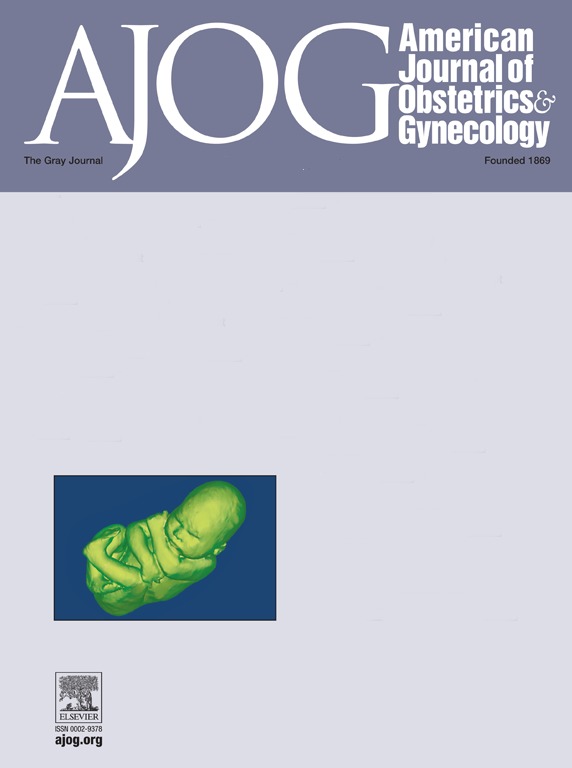Longitudinal Fetal Heart Rate Analysis Identifies Neonates with Metabolic Acidemia Requiring Therapeutic Hypothermia.
IF 8.4
1区 医学
Q1 OBSTETRICS & GYNECOLOGY
引用次数: 0
Abstract
BACKGROUND Despite widespread use of intrapartum fetal monitoring, rates of fetal brain injury remain unchanged. Neonatal encephalopathy due to hypoxia-ischemia is a leading cause of neonatal morbidity and mortality, often occurring in the absence of acute intrapartum events. Current fetal heart rate interpretation guidelines rely on static, cross-sectional assessments and offer limited guidance for managing "indeterminate" patterns. Machine learning provides an objective, longitudinal analysis of the entire intrapartum fetal heart rate tracing and may enhance the identification of fetuses at risk for neurological injury. OBJECTIVE To evaluate whether a longitudinal machine learning-based analysis of abnormal fetal heart rate patterns-and their duration-throughout labor can identify neonates requiring therapeutic hypothermia among those born with acidemia. STUDY DESIGN We conducted a retrospective case-control study of neonates born with metabolic acidemia (umbilical or neonatal arterial pH ≤7.15 or base deficit ≥10 mmol/L) who met clinical, biochemical, and neurologic criteria for therapeutic hypothermia (study group). These were compared to a control group of neonates who met clinical and biochemical criteria, but did not meet neurologic criteria for therapeutic hypothermia. Neonates with acute sentinel events were excluded. Maternal and neonatal characteristics were abstracted from electronic medical records. Fetal heart rate tracings for the entire labor course were extracted from the perinatal monitoring system for machine learning analysis. The optimal reading window size was determined by incrementally increasing fetal heart rate tracing reading window sizes by 5-minute intervals until optimal model performance was achieved. After the machine learning-based model was trained for anomaly detection, a two-step process using Isolation Forest followed by Random Forest Classifier was applied to label each window as "normal" or "abnormal." The primary outcome was the proportion of fetal heart rate windows labeled as "abnormal" during the entire intrapartum course for each fetus. T-tests, Wilcoxon rank-sum tests, chi-square tests, or Fisher's exact tests were used as appropriate. RESULTS There were 44 mother-infant pairs included, with 22 in each group. There were no significant differences between the study and control groups in umbilical cord pH or base deficit levels. Maternal and neonatal characteristics, duration of tracing analyzed, intrapartum events, and delivery outcomes were similar between groups. The study group had significantly lower APGAR scores, higher Sarnat scores, increased seizure incidence, elevated initial AST and ALT levels, and longer lengths of stay (all p < .03). The proportion of "abnormal" 90-minute intrapartum windows was significantly higher in the study group (73.3% ± 15.2%) compared to the control group (4.9% ± 3.3%; p < .001). CONCLUSIONS The higher proportion of "abnormal" 90-minute windows in cases requiring therapeutic hypothermia provides evidence that the duration of abnormal patterns is a key indicator of significant fetal compromise. Our findings also suggest that traditional perinatal clinical characteristics may have limited predictive value for identifying fetuses at risk of neurologic injury. Continuous, objective analysis of the entire intrapartum tracing may improve detection of evolving fetal compromise, enhance interpretation of fetal heart rate patterns, and reduce the rate of unnecessary interventions.纵向胎儿心率分析确定新生儿代谢性酸血症需要治疗性低温。
背景:尽管广泛使用产时胎儿监护,胎儿脑损伤的发生率保持不变。缺氧缺血引起的新生儿脑病是新生儿发病和死亡的主要原因,通常在没有急性产时事件的情况下发生。目前的胎儿心率解释指南依赖于静态的横断面评估,对管理“不确定”模式提供有限的指导。机器学习提供了对整个产时胎儿心率追踪的客观、纵向分析,并可能增强对神经损伤风险胎儿的识别。目的:评估基于纵向机器学习的异常胎儿心率模式及其分娩持续时间分析是否可以在出生时患有酸血症的新生儿中识别需要治疗性低温治疗的新生儿。研究设计:我们对符合临床、生化和神经学标准的代谢性酸血症新生儿(脐带或新生儿动脉pH≤7.15或碱基缺陷≥10 mmol/L)进行了回顾性病例对照研究(研究组)。将这些新生儿与符合临床和生化标准,但不符合治疗性低温的神经学标准的对照组进行比较。排除有急性前哨事件的新生儿。从电子病历中提取产妇和新生儿的特征。从围产期监测系统中提取整个产程的胎心率,进行机器学习分析。最佳阅读窗口大小是通过每隔5分钟逐渐增加胎儿心率追踪阅读窗口大小来确定的,直到达到最佳模型性能。在对基于机器学习的模型进行异常检测训练后,使用隔离森林和随机森林分类器进行两步处理,将每个窗口标记为“正常”或“异常”。主要结果是每个胎儿在整个产时过程中标记为“异常”的胎儿心率窗口的比例。适当使用t检验、Wilcoxon秩和检验、卡方检验或Fisher精确检验。结果共纳入44对母婴,每组22对。在脐带pH值或碱基缺陷水平上,研究组和对照组之间没有显著差异。产妇和新生儿的特征、随访时间、产时事件和分娩结果在两组之间相似。研究组患者APGAR评分较低,Sarnat评分较高,癫痫发作发生率增高,AST和ALT初始水平升高,住院时间较长(均p < 0.05)。研究组90分钟产时窗“异常”比例(73.3%±15.2%)明显高于对照组(4.9%±3.3%;p < .001)。结论在需要低温治疗的病例中,“异常”90分钟窗口的比例较高,这表明异常模式的持续时间是胎儿严重损害的关键指标。我们的研究结果还表明,传统的围产期临床特征可能对识别有神经损伤风险的胎儿具有有限的预测价值。对整个产时追踪进行持续、客观的分析,可以提高对胎儿损伤的检测,增强对胎儿心率模式的解释,并减少不必要的干预。
本文章由计算机程序翻译,如有差异,请以英文原文为准。
求助全文
约1分钟内获得全文
求助全文
来源期刊
CiteScore
15.90
自引率
7.10%
发文量
2237
审稿时长
47 days
期刊介绍:
The American Journal of Obstetrics and Gynecology, known as "The Gray Journal," covers the entire spectrum of Obstetrics and Gynecology. It aims to publish original research (clinical and translational), reviews, opinions, video clips, podcasts, and interviews that contribute to understanding health and disease and have the potential to impact the practice of women's healthcare.
Focus Areas:
Diagnosis, Treatment, Prediction, and Prevention: The journal focuses on research related to the diagnosis, treatment, prediction, and prevention of obstetrical and gynecological disorders.
Biology of Reproduction: AJOG publishes work on the biology of reproduction, including studies on reproductive physiology and mechanisms of obstetrical and gynecological diseases.
Content Types:
Original Research: Clinical and translational research articles.
Reviews: Comprehensive reviews providing insights into various aspects of obstetrics and gynecology.
Opinions: Perspectives and opinions on important topics in the field.
Multimedia Content: Video clips, podcasts, and interviews.
Peer Review Process:
All submissions undergo a rigorous peer review process to ensure quality and relevance to the field of obstetrics and gynecology.

 求助内容:
求助内容: 应助结果提醒方式:
应助结果提醒方式:


